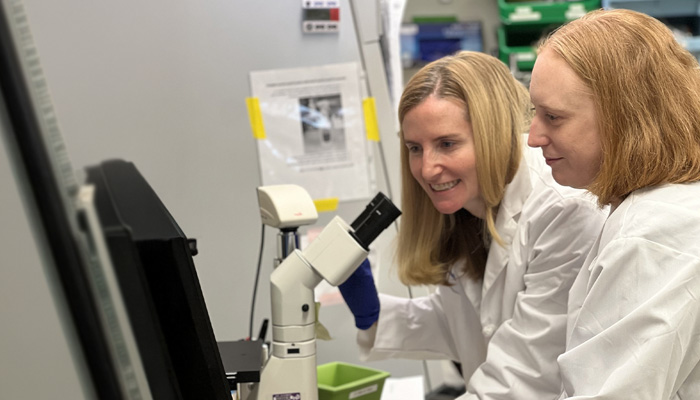HOW CAN WE HELP YOU? Call 1-800-TRY-CHOP
In This Section
CHOP Frontier Program to Transform Personalized Care of Eosinophilic Esophagitis

Drs. Melanie Ruffner (right) and Amanda Muir co-lead the Transforming Eosinophilic Esophagitis Frontier Program to advance personalized patient care for EoE.
Thirty years ago, eosinophilic esophagitis (EoE) was relatively unknown. Now, with diagnoses on the rise, a new Frontier Program at Children's Hospital of Philadelphia will combine multidisciplinary expertise to position CHOP as a leader in pediatric EoE care and research.
The Transforming EoE Frontier Program seeks to expand access to minimally invasive diagnostic tools, reduce reliance on repeated endoscopy procedures, and develop more personalized therapeutic treatment options for patients. Researchers seek to cultivate a deeper understanding of EoE disease patterns and the biological mechanisms that drive them to help more patients achieve remission.
EoE is a chronic, allergic inflammatory disease of the esophagus that can cause difficulty swallowing. While the esophagus remains inflamed, patients are more at risk for complications with fibrosis and scarring.
"Our dream for this program is eventually, as soon as a patient is diagnosed with EoE, we can look at their molecular features to predict if they are at high risk for complications and to determine the best therapy for tailored care," said Co-leader of the Frontier Program, Amanda Muir, MD, an Attending Physician in the Division of Gastroenterology, Hepatology, and Nutrition at CHOP.
Dr. Muir is leading the Transforming EoE Frontier Program alongside Melanie Ruffner, MD, PhD, an Attending Physician in the Division of Allergy and Immunology; and Jonathan Spergel, MD, PhD, Chief of the Allergy Section and Co-founder of the Center for Pediatric Eosinophilic Disorders (CPED).
Pioneering Less Invasive Diagnostic Tools
Since there are no known noninvasive biomarkers to detect EoE, doctors typically perform an endoscopy, a procedure in which a small scope is inserted down the throat, while a patient is under anesthesia to collect a sample for biopsy. Leaders of the Frontier Program aim to offer two minimally invasive diagnostic procedures as safe alternatives for families that reduce risks associated with anesthesia.
Researchers will support this goal is by expanding the clinical use of transnasal endoscopy, which does not require anesthesia. Doctors gently insert a thin, flexible tube through the nose to examine the esophagus for evidence of inflammation.
The Transforming EoE Frontier Program also will establish a second, less invasive diagnostic procedure known as the esophageal string test. Patients swallow a pill-sized capsule containing an absorbent string. Once the capsule dissolves, the string sits in the esophagus for an hour to absorb different proteins in the mucus. Doctors send the string to a lab to detect any signs of eosinophilic inflammation.
"If we can come up with a way to sample the esophagus that prevents even a handful of the scopes that patients currently undergo, we'll have really moved the needle forward in terms of care," Dr. Muir said.
Strides Towards Molecular, Genetic Innovation
Researchers aim to develop genetic and molecular profiles for EoE patients, with support from the Center for Applied Genomics, by expanding the clinical use of EndoFLIP™ — a special tool that can be used during endoscopies to measure width, flexibility, and motility of the esophagus — and leveraging electronic health record data from one of the first genetic studies of EoE led by Dr. Spergel and his CPED colleagues.
This information, combined with a patient's blood work, could help predict which types of medication will have a better response for the patient. Analysis of protein patterns and biopsy findings also could help scientists predict which children could be at a higher risk for fibrosis.
"Through this Frontier Program, we hope we can give families more specific information about which therapies could be a better match for their child," Dr. Ruffner said.
Investigators are also developing organoid models from the biopsy findings to understand how therapies can be more efficiently delivered to the esophagus. Working with investigators in the Department of Pathology and Laboratory Medicine, researchers are exploring the use of lipid nanoparticles as vehicles for more targeted delivery of medicines.
The Frontier Program leaders welcome multidisciplinary collaboration and invite experts in other fields at CHOP to reach out with ideas on how to advance the treatment and care of patients with EoE.
"At CHOP, we have the resources and the expertise that help us work well as a team," Dr. Spergel said. "[This, along with] our supportive patient community allows us to make breakthroughs in personalized care for patients with EoE."